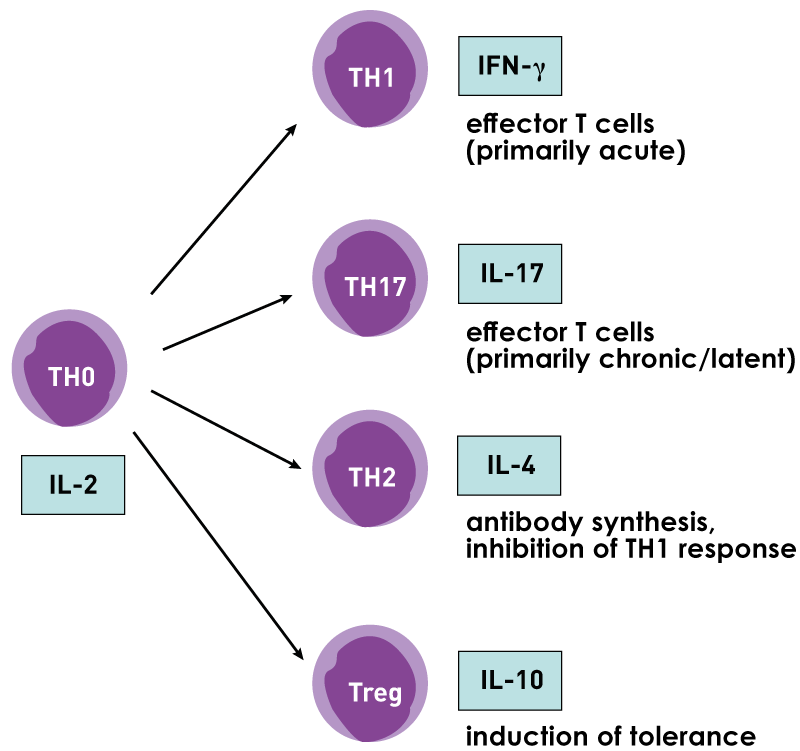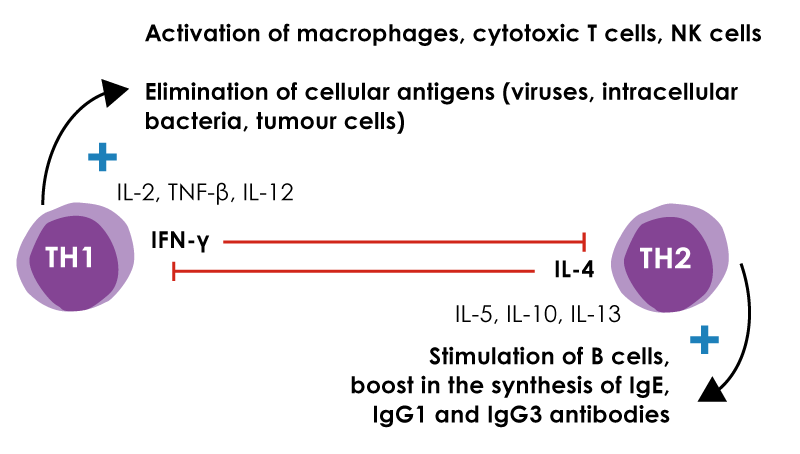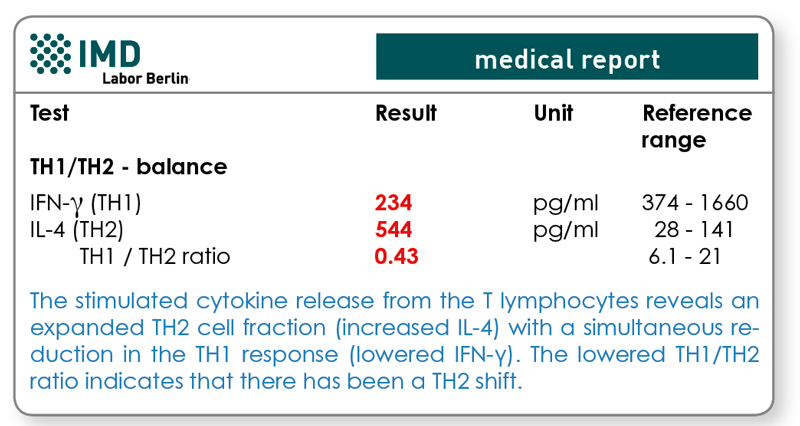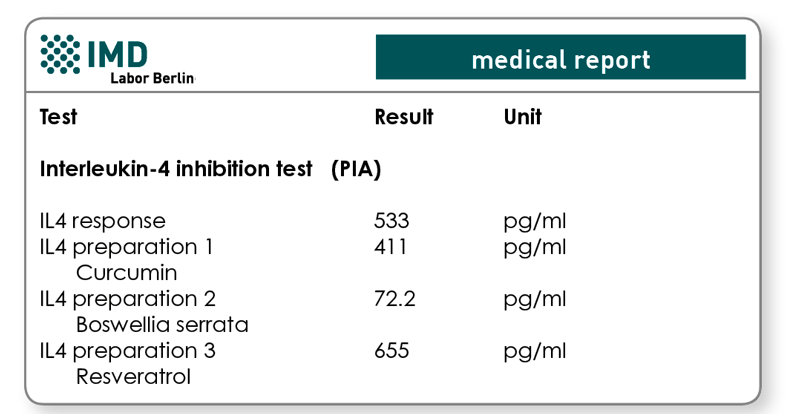Analysis and modulation of the TH1/TH2 cytokine balance
CD4+ helper cells form the key regulatory unit of our adaptive immune system. The total number of CD4+ helper cells can be measured in the cellular immune profile but this does not provide any information about the distribution of the functional subpopulations. Depending on the type of cytokines they secrete, CD4+ helper cells are classified into five subgroups, all of which have different and in some cases opposing func-tions (see Fig. 1). The five subgroups are analysed in the TH1/TH2/TH17 profile.

In light of the costs, often only the TH1 and TH2 immune system is examined, particularly for chronic inflammatory diseases, because these two subpopulations are pathognomonic independently of the Treg and TH17 cells. These two subpopulations are identified by their marker cytokines interferon-gamma (IFN-γ = TH1 marker) and interleukin-4 (IL-4 = TH2 marker) following stimulation of patient lymphocytes with T cell stimulants (ConA/SEB).
Interferon-γ
IFN-γ is the most important effector and marker cytokine of TH1 helper cells. It triggers proinflammatory immune responses. The processes induced by IFN-γ serve to efficiently eliminate an intracellular pathogen (viruses, intracellular bacteria) but may also damage tissues and be responsible for chronic inflammatory diseases if their response is excessive or inadequate (type IV immune responses).
Interleukin-4
IL-4, like IL-5, IL-10 and IL-13, is secreted by TH2 helper cells. These interleukins facilitate the differentiation of B cells into plasma cells and stimulate them to synthesise antibodies. An increase in IL-4 synthesis indicates a dominant TH2 immune response and often occurs in atopic persons and some autoimmune diseases. In the advanced stages of various chronic infections and inflammatory diseases, there is often a TH2 shift that further encourages chronification.
Because TH1 and TH2 cells have antagonistic effects on one another, that is, they mutually inhibit the other’s function, TH2 dominance is usually associated in the medium and long term with a weakening of the TH1 immune response and vice versa. This is one explanation for the immunodeficiency that is commonly associated with chronic inflammatory diseases.

Interpretation of the results
TH1 dominance (IFN-γ ↑, IL-4 ↓) is usually a consequence of an increased but otherwise intact immune response, e.g., during an ongoing infection but also as a result of therapeutic immunostimulation. TH2 dominance, on the other hand, is a pathognomonic factor indicating progression of many chronic inflammatory diseases. TH2 dominance (IFN-γ ↓, IL-4 ↑) is often seen in immediate-type allergic reactions such as hay fever, asthma, atopic dermatitis, psoriasis, a range of autoimmune diseases caused by auto-antibodies, chronic infections and inflammatory bowel diseases as well as often being detected secondary to cancer.
Determining the TH1/TH2 balance is indicated particularly before and during immunomodulatory therapy to verify the treatment outcomes.
Material
5 ml heparin blood
Sample receipt within 24 hrs has to be ensured. The sample should be stored and transported at room temperature. Within the Berlin city area, we offer a courier service (+49 (0)30 7701- 250). For collections beyond Berlin, please contact our complimentary courier service (+49 (0)30 77001- 450).
Invoicing
Please obtain the costs for the analysis from the pdf-document.
IL-4 inhibition test to evaluate the individual response to TH2-reducing preparations
Particularly for chronic inflammatory diseases and with a verified TH2 shift in the cellular immune response (IL-4 ↑, IFN-γ normal or ↓), an adjuvant immunomodulatory therapy can be administered that aims to lower the increased IL-4 values. In practice, a range of preparations are used, however, they show highly individual differences between patients in terms of their efficacy. Therefore, preliminary testing using the IL-4 inhibition test is useful for selecting the most efficacious preparation in vitro for a particular individual.
TH1 dominance (IFN-γ ↑, IL-4↓) usually occurs in acute or subacute T-cellular immune reactions. From a therapeutic point of view, the focus here is on causal diagnostics (infections?, autoimmune reactions?, others?), which is why we do not work on an IFN-γ inhibition test for laboratory diagnostics.
Material for the IL-4 inhibition test
5 ml heparin blood
The preparations to be tested must be indicated or sent to the laboratory along with the blood. Sample receipt within 24 hrs has to be ensured. The sample should be stored and transported at room temperature. Within the Berlin city area, we offer a courier service (+49 (0)30 7701- 250). For collections beyond Berlin, please contact our complimentary courier service (+49 (0)30 77001-450).
Invoicing for the IL-4 inhibition test
Please obtain the costs for the analysis from the pdf-document.
Would you like to see a presentation on the matter?
In our video archive, you can find a free presentation on this topic. Access is free und possible without prior registration.


